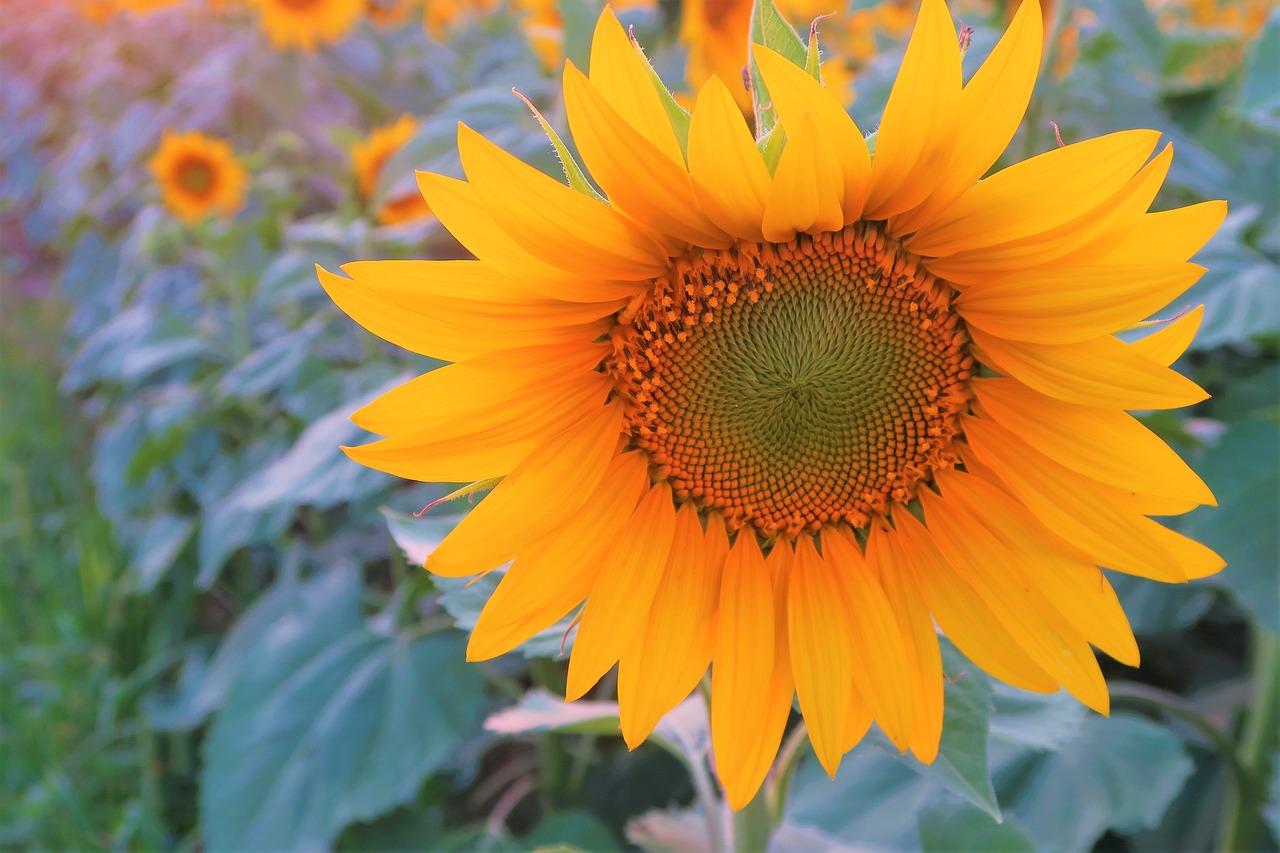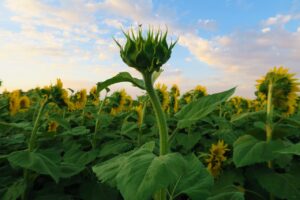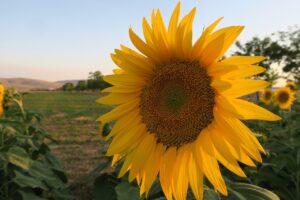Sunflower
Overview
The sunflower plant, known as Helianthus, is a vibrant crowd-pleaser, cherished for its spectacular display of golden blooms. Native to the Americas, this plant belongs to a family boasting nearly 70 species. It’s not just a joy to behold but a marvel of versatility, offering both aesthetic delight and practical benefits—from ornamental to soil remediation roles. These sun-loving giants capture the essence of summer with their radiant faces and the bounty of seeds they gift when autumn whispers its arrival.

Characteristics
Known for their large, showy flower heads, sturdy, upright stems, and ability to thrive in sunny conditions and remove toxins from soil.
Region
Native to North and South America and cultivated in temperate and warmer climates worldwide.
Natural Habitat
Sunflowers are usually found in open fields and prairies.
Cultivation
Thrives in full sun, moderate water, and well-drained soil with good fertility.
Uses and Benefits
Sunflowers are not just pretty faces in the garden; they are also incredibly versatile and practical plants. Varieties like ‘Aztec Sun’ and ‘Mongolian Giant’ add a burst of cheerful color to any outdoor space2. But beyond their striking appearance, sunflowers are also environmental superheroes. They have the impressive ability to extract harmful toxins from soil, a feat that has been utilized in areas affected by nuclear incidents2.
As summer transitions into fall, sunflower seeds take center stage. These nutritious seeds are harvested and enjoyed as a healthy snack by both humans and birds5. Sunflower seeds are:
- Rich in vitamins and minerals
- High in healthy fats and protein
- A great source of fiber
- Delicious raw, roasted, or added to recipes
From enhancing garden aesthetics to improving health and restoring ecosystems, sunflowers are truly natural wonders. They offer a wide range of benefits:
- Aesthetic appeal: Sunflowers add a bright, cheerful touch to gardens and outdoor spaces.
- Environmental restoration: They can help clean up soil by absorbing toxins and heavy metals.
- Nutritional value: Sunflower seeds are a nutrient-dense snack for both humans and wildlife.
- Versatility: Sunflowers can be used for ornamental purposes, food production, and even eco-friendly initiatives.
So, whether you’re a gardener looking to add a pop of color or an environmentally conscious individual seeking a natural way to improve soil health, sunflowers are a fantastic choice. These towering beauties not only make a statement in the garden but also contribute to a healthier planet and provide nourishment for all.

Cultivation Tips
To ensure your sunflowers stand tall and bright, a bit of groundwork is key. Loosen the soil well to encourage healthy root development, as this plays a crucial part in the plant’s support structure. When planting seeds, give them a good start by following these steps:
- Bury seeds 2.5 to 5 cm deep into the soil
- Space each seed 10-15 cm apart from its neighbors
- This allows each sunflower ample room to bask in the sun’s glory
These sunny beauties adore light and will thrive in full sun, reveling in the warmth throughout the summer. While robust and mostly pest-resistant, keep an eye on your local frost dates. Planting just before the last expected frost will let your sunflowers seize the growing season and flourish.
Enjoy the buzz of pollinators they attract and later, the bounty of seeds that invite a dance of birds to your garden as summer gives way to autumn.
Seasonal Considerations
To ensure your sunflowers stand tall and bright, a bit of groundwork is key. Make sure the soil is well-loosened to encourage healthy root development—this plays a crucial part in the plant’s support structure. When planting seeds, give them a good start by burying them 2.5 to 5 cm deep into the soil, ensuring each seed has its own space with 10-15 cm apart from its neighbors. This allows each sunflower to have ample room to bask in the sun’s glory.
Remember, these sunny beauties adore light and will thrive in full sun, reveling in the warmth throughout the summer. While robust and mostly pest-resistant, keep an eye on your local frost dates; planting just before the last expected frost will let your sunflowers seize the growing season and flourish. Enjoy the buzz of pollinators they attract and later, the bounty of seeds that invite a dance of birds to your garden as summer gives way to autumn.
Some key seasonal considerations for growing sunflowers:
- Spring: Plant sunflower seeds directly in the garden after the last frost date. Ensure the soil is warm and well-draining.
- Summer: Sunflowers thrive in the summer heat and full sun. Water deeply but infrequently to encourage deep root growth. Stake tall varieties to prevent them from toppling over in the wind.
- Late Summer to Early Fall: Sunflowers bloom, attracting pollinators and birds. Leave mature flower heads on the plants to provide food for wildlife and to allow the seeds to ripen for harvesting.
- Fall: After the first frost, cut sunflower stalks down to about 6 inches above the ground. Compost the stalks or leave them in the garden to provide shelter for beneficial insects over the winter.
By understanding the seasonal needs of sunflowers, you can help these radiant blooms thrive in your garden, providing a spectacular display of color and life from summer to fall.

Issues and Troubleshooting
Sunflowers, with their sunny disposition, are not only a delight to the eye but also offer a myriad of uses. However, like all plants, they can face some roadblocks to their flourishing.
Overwatering is a frequent issue; sunflowers prefer drier conditions and too much water can lead to root rot. Conversely, if sunflowers do not receive enough sunlight, their growth can be stunted, and the flowers may not develop fully.
It’s also common for sunflowers to become top-heavy, especially as they grow taller and their large heads develop. Staking can provide stability for these joyful giants.
Pests, though not a substantial threat due to the plant’s natural resistance, can still pose problems.
- Aphids and other insects sometimes feed on sunflower leaves
- Birds are known to pilfer seeds
Solutions:
- Netting or scare tactics can help safeguard your blooms and seeds from these critters
- Regular monitoring and responsive care will ensure your sunflowers thrive
With proper attention, your sunflowers will offer blossoms that not only beautify your garden but also serve as a boon for pollinators and a potential snack for you and the birds5.
History and Folklore
Sunflowers have woven their golden threads through human history and folklore with their striking presence and sun-like appearance. Native to North and South America, these plants were not only a food source for indigenous people[1] but also held deep spiritual significance.
In various cultures, sunflowers symbolized the sun’s energy and vitality, worshipped for their resemblance to the sky’s brightest star. The Aztecs and Otomi people regarded sunflowers as symbols of their solar deity, while the Incas used sunflower images to decorate their temples.
Throughout time, sunflowers have been adopted in myths and tales, often representing loyalty and adoration, as the blossoms turn to follow the sun’s path across the sky. Greek mythology tells the story of Clytie, a nymph who was turned into a sunflower after gazing lovingly at Apollo, the sun god, for nine days straight.
In Chinese culture, sunflowers are associated with long life, good fortune, and vitality. They are often given as gifts during the Chinese New Year and Mid-Autumn Festival to convey good wishes and prosperity.
Even in modern storytelling, sunflowers continue to be metaphors for positivity and unwavering faith. Their vibrant petals and towering stems have inspired countless artists, from Vincent van Gogh’s famous series of sunflower paintings to contemporary literature and poetry celebrating the flower’s resilience and beauty.
References
1. Sunflower | Description, Uses, & Facts | Britannica, https://www.britannica.com/plant/sunflower-plant
2. Common sunflower | Kew, https://www.kew.org/plants/sunflower
3. Sunflower | Diseases and Pests, Description, Uses, Propagation, https://plantvillage.psu.edu/topics/sunflower/infos
4. How to Grow and Care for Sunflowers – The Spruce, https://www.thespruce.com/growing-sunflowers-1402916
5. Sunflowers: How to Plant, Grow, and Care for Sunflower Plants | The Old …, https://www.almanac.com/plant/sunflowers
Nicolas Duval
Nicolas is a passionate advocate for nature and the art of wildcrafting. His dedication shines through in Wildcraftia, a website he meticulously crafted to serve as a haven for nature enthusiasts worldwide. Driven by a deep appreciation for nature’s connection to humanity, Nicolas embarked on his journey in 2011 with SmokableHerbs, a platform showcasing his love for nature’s bounty. Building upon this foundation, he established Smokably, a thriving online store offering premium herbs and blends to a global audience.
